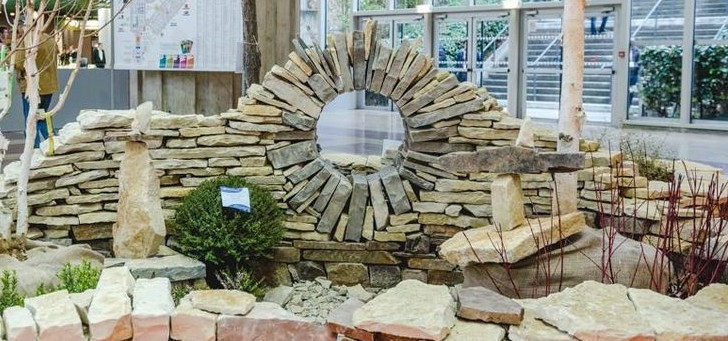Choosing the right natural stone when creating a green space
As good indoors as out, landscapers and interior decorators find everything they need in natural stone! But like plants, several factors have to be considered when choosing the right stone for designing green spaces. To help you with your choice we asked landscape architect Sophie Labouré who designed the Paysalia and Rocalia 2017 visit preparation center for some technical advice.

As good indoors as out, landscapers and interior decorators find everything they need in natural stone! But like plants, several factors have to be considered when choosing the right stone for designing green spaces. To help you with your choice we asked landscape architect Sophie Labouré who designed the Paysalia and Rocalia 2017 visit preparation center for some technical advice.

Natural stone has so many benefits

Sophie Labouré’s business is focused on natural stone.
“Stone is resistant, durable in time and unique because it cannot be manufactured industrially. There is an immense choice of colors, formats and assemblies. Whatever the project - paths, walls and partitions, dry stone walls or sculptures - there is the right stone for everything! It actively contributes to giving every space a unique character”. And there is something else. “It will evolve and become even more beautiful over time. And it’s easy to look after, too!”
Natural stone is also ideal for hypoallergenic gardens!
Basic natural stone choice criteria
When you buy natural stone, the dealer or the quarry should give you a data sheet in specifying all its properties. Here’s how to use them when you design green spaces!
What is the stone being used for?
![]()
Several factors have to be considered. They basically depend on what the stone is being used for. “Firstly, is the place busy? An alley with high traffic needs different stone from terraces only used occasionally. The answer dictates the stone’s hardness (compressive strength) and density so it meets the pressure put on it. The next factor is its resistance to freezing. Water is its natural enemy and it would be a shame if cracks were to develop after a few winters. Lastly, its resistance to the chemicals, for example at swimming pool beaches on which chemicals from the pool are often splashed. ”
Looks
![]()
To ensure visual coherence natural stone must blend into its surroundings. Finishing is also essential: “Surface treatments give textures and visual effects. The possibilities are numerous: stone can be hammered, flashed, cleaved or bush-hammered… For example, with a single kind of natural stone you can create different spaces while preserving a visual unity by applying different treatments.”
Technicalities
![]()
“The type of ground on which you are going to execute the work must be considered before anything else. You can lay stone on a concrete base for drainage, on studs so water will infiltrate via the stone joints and on sand beds… ”.
Care with drainage needs to be taken with stone paths to prevent surfaces from becoming slippery: “Water must not stagnate on surfaces. It must be drained away from buildings so that moisture does not accumulate. Pathways must have a drainage slope. The degree of slope can vary depending on the stone and its finish. The rougher the surface the steeper the slope needs to be - 1% if the surface of the stone is smooth and up to 3-5% if the surface is very rough.” To prevent cracks and breaks in the stone, take care when laying and do not forget expansion joints which require great attention and must be executed with great skill. “Just like wood, stone expands naturally. Expansion joints make it possible for stone to expand and contract flexibly all year round.” And a hint for laying: for best looks, mix stones from different pallets!
Costs
![]()
Everyone can afford natural stone but the cost varies with format and variety. “Standard dimensions are less expensive to produce than big paving blocks for which the quarry has to cut the stone from a single block.” Natural stone properties also depend on where it is extracted, which also affects cost: “For example, Europe has magmatic rocks with very good properties but they are more expensive than Asian granite which has a different make-up. Using local stone promotes local know-how, a sustainable economy and is more environmentally-friendly.”
Short list of the natural stones most commonly used in green spaces design
Are you ready to use natural stone in your next projects? Here is a short list of the natural stones commonly used in landscaping:
- Magmatic rocks are produced by solidified magma, they include granite, basalt and porphyry.
- Sedimentary rocks are produced by the build-up of sediments, this category includes the various types of limestone, travertine and sandstone.
- Metamorphic rocks are produced by the transformation of rocks heated under pressure and include gneiss, slate, quarzite and marble.
Proof of the close link between landscaping and natural stone, Rocalia, the natural stone show, is held in synergy with Paysalia, our landscaping show. So come to the next session in 2019 to see all the know-how involved in using natural stone! We would like to thank Sophie Labouré for sharing her expertise.
Photo credit: Rocalia show
Icons: Icons8

